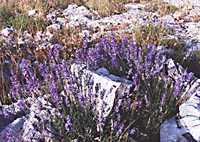Provence-Beyond (Beyond the French Riviera) ®
Photos:
Lavender fields in Beyond (22 k)
Lavender distillery at Barreme (13 k)
| Also: | [ True Lavender | French Lavender ] |
| [ Lavender Fields of Provence ] |
| family: Labiatae (Mint) |
 Lavender is native to the Southern Alps, and different varieties grow wild throughout the Beyond region. In the 16th century, the Provençal peasants produced lavender oil to heal wounds and expel intestinal worms. The true lavender (Lavendula angustifolia) that thrives in the chalky soils and hot, dry climate of higher altitudes of the Provence was picked systematically at the end of the 19th century. At the beginning of the 20th century, fields of lavender were first planted, at altitudes above 700 m. Since the true lavender grows best at over 700 m, a hybrid, Lavandin, was developed for cultivation at lower altitudes.
Lavender is native to the Southern Alps, and different varieties grow wild throughout the Beyond region. In the 16th century, the Provençal peasants produced lavender oil to heal wounds and expel intestinal worms. The true lavender (Lavendula angustifolia) that thrives in the chalky soils and hot, dry climate of higher altitudes of the Provence was picked systematically at the end of the 19th century. At the beginning of the 20th century, fields of lavender were first planted, at altitudes above 700 m. Since the true lavender grows best at over 700 m, a hybrid, Lavandin, was developed for cultivation at lower altitudes.
Flowers and leaf-stalks can be dried for perfuming bed-linen and to keep moths away from your clothes. Lavender essence is used commercially in the perfume, soap and pharmaceutical industries. Dried lavender is is packaged in small cloth sacks and sold worldwide. Dried lavender is also used for cooking and for herbal cures. There is a strong cottage industry in the Beyond region of lavender products.
Blooming
Lavender fields begin blooming in June, depending on the area and the seasonal weather. Our photos of lavender fields have been taken from the first of July to mid October. Our photos of the wild Lavender Stochas have been taken as early as mid March.
Harvest
Lavender is harvested from July to September, when the hot summer sun brings the essence up into the flower. The harvesting is done with more and more automation, but the older fields with narrow rows are still picked by hand. The lavender is dried for 2 to 3 days before being transported to the distillery. Another method (from other sources) was to move a small still from field to field during harvesting, and process the lavender immediately upon picking. Whether immediate or with dried lavender, there were "mobile" stills, and later, small stills were built at many of the fields.
Distilling
The distillation is done in a steam alembic, with the dry lavender steamed in a double boiler. (Here's a photo of the lavender distillery at Barrème.) The essential oils are extracted from the lavender by the water vapor and are passed through the cooling coils of a retort. The condensation provides the final mixture of essence and water.
A ton of dry lavender passes through the alembic in about 30 minutes. Lavandin produces from 25-40 kg of essence, and true lavender produces from 5-10 kg, but of a better quality.
Lavender Fields
Some of the larger cultivated lavender fields are found in the Alpes-de-Haute-Provence (04), including on the slopes of the Lure mountains, near St. Etienne-les-Orgues (map), and on the Sault plateau in the eastern Vaucluse (84)(map). Some specific locations in the Beyond region are:
- Allemagne-en-Provence (04) [map]; road to Montagnac
- Céreste (04); road to Manosque
- Manosque (04) [map]; road to Céreste
- Musée de la Lavande (84); about 7km south of Gordes and Fontaine-de-Vaucluse [map].
- Between the eastern end of the Gorges de la Nesque and Sault there are many large fields
- Montagnac (04) [map]; south, near junction of D11 (big fields)
- Quinson (04) [map]
- Riez
- St. Martin-de-Brôme (04) [map]
- St. Etienne-les-Orgues (04)
- Valensole (04) [map]
Lavender distilleries are also located in the Alpes-de-Haute-Provence (04) and eastern Vaucluse (04). Some towns with distilleries are:
- Allemagne-en-Provence (04) [map]
- Banon (04) [map]
- Barreme (04) - an old distillery
- Ongles (04) [map: 5 km southwest of St Etienne-les-Orgues, 16 km north of Forcalquier]
- Quinson (04) [map]
- Riez (04)
- Sault (84)
- Valensole (04) [map]